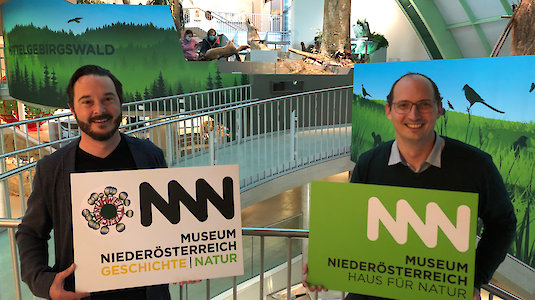Lower Austria`s first green museum
Since December, the Museum of Lower Austria has been a proud bearer of the Austrian Ecolabel. This makes it the first museum in Lower Austria and the third museum nationwide to receive this important award, after the KUNST HAUS WIEN and the Technischen Museum Wien.
The approval process was completed gratifyingly quickly, because sustainability has always been a central theme of the House. The high conservation standards for the objects in the House of History and optimal living conditions for over 40 living native animal species in the House of Nature are not contradictory.

Measures to protect the environment also make economic sense: a holistic control of the climate ensures the optimised use of heating, ventilation and air conditioning, including heat recovery systems. The museum has double-glazed windows for thermal insulation. And energy-saving lighting is predominantly used in the building, to name just three examples. With the award of the Austrian Ecolabel, however, the museum has also made commitments in the form of a four-year plan. For example, the communication of sustainability goals to visitors will be intensified so that the green museum becomes even more of a joint project between staff and guests.
Education & Communication
The House for Nature sees environmental education as one of its central tasks. It is no coincidence that the current exhibition "Climate & Me" was the impetus for a separate task force on sustainability in the museum. In cooperation with the Department of Environmental and Energy Management and the Energy and Environment Agency of the Province of Lower Austria, the show is a guide to action for protecting the climate and can be seen until 29 August 2021. If you want to communicate the protection of nature and biodiversity to your audience, you have to act according to these principles yourself.
The educational offer is very broadly based. It starts with the digital museum, which offers a wide range of programmes from handicraft instructions and animal puzzles for children to its own blog and the country's encyclopaedia memory to virtual guided tours. For adults, the discussion series "Erlebte Natur" (Experienced Nature) offers events with explosive current topics on nature and species conservation, which can also be held virtually in the case. Every first Sunday of the month is "Sunday at the Museum", so there is plenty of programme for families. A special highlight are also the weekly commented feedings of the endangered European pond turtle in summer.
For school classes from the 3rd grade upwards, the programme is just as rich and age-appropriate, ranging from workshops on the current exhibitions to guided tours of the House of Nature. Twice a year, a special focus is placed on schools with the "Adventure Knowledge" action week. The International Children's and Young People's Book Festival brings around 6,000 children and young people into close contact with authors and bookmakers in one week. But there is also a wide range of leisure activities, such as holiday events and birthday parties.

DIVERSITY in the garden
The museum garden is a green oasis for the entire cultural district and the neighbouring government quarter. It is managed strictly according to the criteria of " Natur im Garten" (Nature in the Garden) and has thus been awarded the golden hedgehog several times. Chemical synthetic fertilisers and pesticides are completely avoided here in the presentation of Lower Austria's habitats, as are invasive species. On the other hand, structural diversity is emphasised as the best prerequisite for biodiversity with sunny and shady islands, wet and dry areas or vineyards.

How can I promote biodiversity in my garden?
- Nature-oriented design and structural diversity
- Create structure in the garden, create small habitats
- Important elements in the garden: compost heap, brushwood heap, dry stone wall, deadwood heap, flower meadows, stone heap, water, hedges, indigenous woody plants
- Use native plants
- Go for plant communities typical of the region
- Allow wild seeds to grow
- Create disorder
- Wild corners create a richness of structure
- Garden organically
- Avoid poisons and chemicals in the garden
- Install nesting aids and roosts
- Encourage native beneficial insects
- Greening buildings creates habitat
- and much more --> Umweltzeichen - Biodiversität Infothek
The Austrian Ecolabel is pleased to welcome the Museum of Lower Austria as an important and strong partner in the field of culture and knowledge transfer and would like to thank them for their excellent cooperation in the creation of this article!
